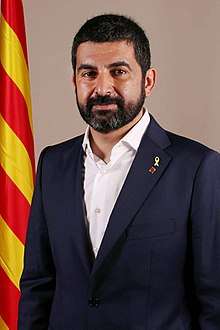Moroccans in Spain
Moroccans in Spain formed 16.4% of the 4,549,858 foreigners in Spain as of 1 January 2017.[5] They are again the largest foreign group in Spain, after they were surpassed temporarily by Romanians in 2007.[6][7][8] In 2003, they were estimated to make up about 6% of all Moroccans abroad.[9]
| ||||
| Total population | ||||
|---|---|---|---|---|
| 934,046[1]Moroccan nationals (2019)[2] | ||||
| Languages | ||||
| Moroccan Arabic, Berber, Haketia, Spanish, French | ||||
| Religion | ||||
| Sunni Islam,[3] with minorities of Judaism and Christianity[4] | ||||
Migration history
Before 1985, Moroccans did not require visas to enter Spain. Many young came for seasonal or short-term work in agriculture and industry, coming and going from Spain without settling there. A new visa law implemented that year, La Ley de Extranjeria, was quite restrictive, and did not provide for permanent residence permits.[10] In 1989, the Asociación de Trabajadores Inmigrantes Marroquíes en España was formed by a group of Moroccan workers to defend their working rights. As late as 1992, official statistics showed only 16,665 Moroccans residing in Spain (of whom 14,998 lived in peninsular Spain).[11] In the following years, many Moroccans came to occupy jobs in the agricultural, hospitality, construction, and service sectors.[3] By 2000, their population had increased to 201,182 individuals. Along with the growing numbers of migrants, their composition also shifted, with a higher proportion of women among them.[12]
2000 also marked a significant shift in Spanish immigration laws; Law 4/2000 passed that year created mechanisms for family reunification, regularisation of illegal migrants, and acquisition of permanent residency.[13] By 2008, official statistics showed 752,695 legal Moroccan residents of Spain.[8] Beginning in September that year, Spanish authorities offered payments to unemployed immigrants if they agreed to cancel their residency and leave the country. With official statistics showing 82,262 unemployed Moroccans in Spain, there were expected to be many who would take advantage of the payments.[14] However, according to provisional figures, the Moroccan population of Spain continued to grow during the year, and had reached 858,000 by the beginning of 2011, 8.8% higher than the 2008 total.[8][15]
Radicalization
Of the 235 jihadists arrested or killed in Spain between 2013-2017, around 46% were of Moroccan descent. 53% were born in Morocco, predominantly the Rif region.[16]
Notable individuals
References
Notes
- https://www.ine.es/jaxi/Datos.htm?path=/t20/e245/p04/provi/l0/&file=0ccaa005.px#!tabs-tabla
- "Población y edad media por nacionalidad y sexo".
- Ambach, Bettina (2004-03-18), "Spain's Muslims: Living on Society's Edge", Deutsche Welle, retrieved 2009-03-24
- Rif Independent Movement
- Urra, Susana (27 Apr 2017). "Spain's population declines for fifth year in a row". El País.
- INE 2009
- INE 2007
- INE 2008
- Khaldi 2003, p. 141
- Empez Vidal 2007, p. 9
- Khaldi 2003, p. 144
- Khaldi 2003, p. 142
- Empez Vidal 2007, p. 10
- Touahri, Sarah (2008-08-06), "Facing unemployment, Moroccans in Spain return home", Maghrebia, retrieved 2009-03-24
- INE 2011
- "Moroccans and the second generation among Jihadists in Spain". realinstitutoelcano.org. Elcano Royal Institute. 27 June 2018. Archived from the original on 14 July 2018. Retrieved 8 April 2020.
Sources
- Empez Vidal, Núria (February 2007), Social construction of neglect: the case of unaccompanied minors from Morocco to Spain (PDF), Working Papers, 7, Max Planck Institute for Demographic Research, retrieved 2009-03-24
- Khaldi, Mohammed (July 2003), "Les Marocains résidant en Espagne: caractéristiques démographiques et sociales" (PDF), in Kabbaj, Khadija (ed.), Marocains de l'Extérieur, Rabat: Fondation Hassan II pour les Marocains Résidant à l’Etranger, pp. 141–206, ISBN 9954-400-19-2, archived from the original (PDF) on 2013-05-06, retrieved 2009-03-24
Data tables
- "Población extranjera por sexo, país de nacionalidad y edad (hasta 85 y más).", Avance del Padrón a 1 de enero de 2009. Datos provisionales, Spain: Instituto Nacional de Estadística, 2009, retrieved 2009-06-13
- "Población extranjera por sexo, país de nacionalidad y edad (hasta 85 y más).", Revisión del Padrón municipal 2008. Datos a nivel nacional, comunidad autónoma y provincia., Spain: Instituto Nacional de Estadística, 2008, retrieved 2009-06-13
- "Población extranjera por sexo, país de nacionalidad y edad (hasta 85 y más).", Revisión del Padrón municipal 2007. Datos a nivel nacional, comunidad autónoma y provincia., Spain: Instituto Nacional de Estadística, 2008, retrieved 2009-06-13
- La Rioja: Población por municipios y sexo:Cifras oficiales de población resultantes de la revisión del Padrón municipal a 1 de enero de 2011, Spain: Instituto Nacional de Estadística, 2011, archived from the original on 21 May 2012, retrieved 27 May 2012
Further reading
- Izquierdo Escribano, Antonio (July 2003), "L'immigration en Espagne" (PDF), in Kabbaj, Khadija (ed.), Marocains de l'Extérieur, Rabat: Fondation Hassan II pour les Marocains Résidant à l’Etranger, pp. 122–140, ISBN 9954-400-19-2, archived from the original (PDF) on 2013-05-06, retrieved 2009-03-24
- López García, Bernabé; Berriane, Mohamed, eds. (2004), Atlas de la inmigración marroquí en España, Taller de Estudios Internacionales Mediterráneos, Autonomous University of Madrid, ISBN 84-7477-951-0, retrieved 2009-03-24
- Martín Muñoz, G.; García Castaño, F. J.; Lopez Sala, A.; Crespo, R. (2003), Marroquíes en España: Estudio sobre su integración, Madrid: Fundación Repsol YPF
See Also
- Algerians in Spain
- Senegalese people in Spain
.jpg)
.jpg)
